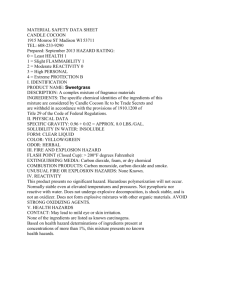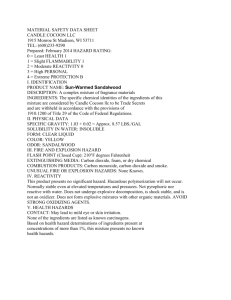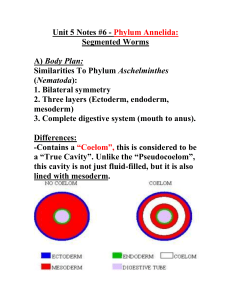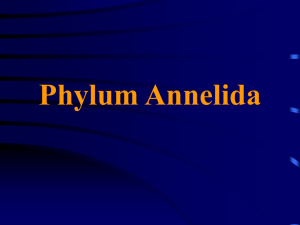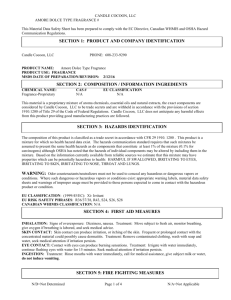Taming Cocoon
advertisement
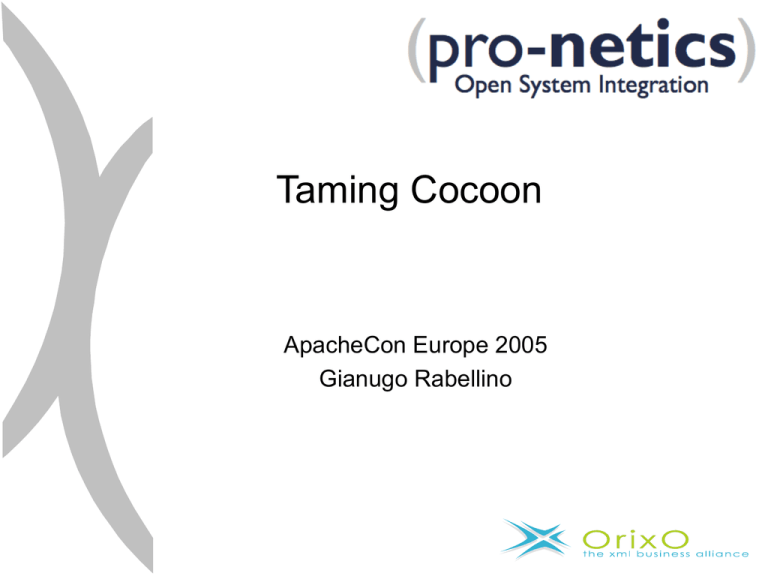
Taming Cocoon
ApacheCon Europe 2005
Gianugo Rabellino
Agenda
Introduction
Installing Cocoon
Dissecting Cocoon
Management and configuration
A sitemap tour
Cocoon components and blocks
Understanding continuations and flow
Dealing with forms
Patterns, best practices, pitfalls
Introduction: web developer
nightmares
out.println(“<table border=\”0\”>\n\t<tr>\n\t\t” +
“<td align=\”left\”><font size=\”+1\”>” +
request.getParameter(“lousyjob”) +
“Does your boss know you\'re typing HTML?” +
“</td>\n\t</tr>\n</table>\n”);
Nightmare: managing HTML
Your IDE can't deal with HTML
Dreamweaver can't deal with business logic
Period.
Oh, and JSPs suck. Big time.
“Separate concerns” - Edsger Dijkstra - 1974
Nightmare: handling state
HTTP is stateless (did you notice already?)
Where am I now?
Restart required
Sessions == overpopulated mess of dictionaries
Nightmare: managing user input
Validation hell
Conversion ordeal
Binding torture
The infamous Back button, oh my!
There has to be a better way
“Never let a man do what a machine can do for him”
Blaise Pascal
Apache Cocoon
A fast-paced overview
Apache Cocoon: facts and figures
Origins
Started by the Italian student Stefano Mazzocchi
Redesign of Apache.org
Frustrated by the limitations of HTML
Wanted to use emerging technologies (XML/XSL)
Today
Now one of the most important Apache projects
Incorporates technologies from various project
Just under 2000 registered on all mailing lists
Includes major companies such as HP, IBM
Tucking web devs in, kissing them
goodnight
10.000ft overview
Key Cocoon concepts
URI space decoupling
Componentized resource assembling
Datasource connections and decoupling
Stateful applications
And their implementation...
URI space decoupling
Sitemap
Componentized resource assembling
Pipelines
Datasource connections and decoupling
Source interface and implementations (file, URL, database,
WebDAV, XMLDB...)
Stateful applications
Web continuations
URI space decoupling: the sitemap
Think <servlet-mapping> on steroids
Pattern freaks think FrontController
Uses pluggable algorithms:
Wildcard
Regexp
Your own
Matching the whole HTTP environment:
Request URI/parameters/attributes
Session attributes
Cookies, context, etc...
Welcome to the sitemap
A sitemap example
<map:match pattern="news/*" type="wildcard">
<map:generate src="newsfeeds/{1}.xml" type="file"/>
<map:transform src="news2html.xsl" type="xslt"/>
<map:serialize type="html"/>
</map:match>
<map:match pattern="products/*" type="wildcard">
<map:generate src="products/infos/product_{1}.xml"
type="file"/>
<map:transform src="products2html.xsl" type="xslt"/>
<map:serialize type="html"/>
</map:match>
Resource assembling: the pipeline
Task: find the total number of unique hosts visiting the home
page of your site
Windows solution:
#include <stdlib.h>
...
Unix solution:
$ grep index.html access.log | awk '{print $2 }' | sort |
uniq | wc -l
Welcome to the pipeline: specialized components glued
together
The Cocoon pipeline
Two simple rules:
Data stream is based on SAX events
Pipelines start with one Generator (and only one), have 0-n
Transformers, end with one (and only one) Serializer
Generators: adapters from the outside world to SAX events
Transformers: SAX event manglers
Serializers: adapters from SAX events to the outside world
A pipeline example
<map:match pattern="*.html">
<map:generate src=”xdocs/{1}.xml"/>
<map:transform src=“style/xdocs2html.xsl”/>
<map:serialize/>
</map:match>
Datasource virtualization
Virtualization layer over stream-based data sources
Provides a java.io.File like interface for a number of data
sources
Think URLs on steroids
The Source interface
A datasource example
<map:match pattern="news/*" type="wildcard">
<map:generate src="webdav://repo/newsfeeds/{1}.xml" type="file"/>
<map:transform src="xmldb://localhost/db/news2html.xsl"
type="xslt"/>
<map:serialize type="html"/>
</map:match>
<map:match pattern="products/*" type="wildcard">
<map:generate src="cocoon://products/infos/product_{1}.xml"/>
<map:transform src="resource://products2html.xsl" type="xslt"/>
<map:serialize type="html"/>
</map:match>
Summing it up
The sitemap decouples URI space from physical
resources
The pipeline decouples results from the way they're built
XML decouples content from presentation
The source abstraction decouples data sources from
physical locations
Result: full Separation of Concerns
(and you ain’t seen nothing yet...)
Web Continuations
The next revolution
Web applications are easy!
But wait, this is stateless HTTP
Webapps are finite state machines
Upon every click, processing starts from the beginning
Again, and again, and again
A typical web application clutter
What are continuations?
“A continuation is an entire set of closures that make up a point of
execution”
“A continuation is an object that, for a given point in your program,
contains a snapshot of the stack trace, including all the local
variables, and the program counter”
Hmmm... so what?
var cart;
var user;
A flowscript example: where the magic
happens
function checkout()
{
while(user == null) {
cocoon.sendPageAndWait("login.html");
user = UserRegistry.getUser(cocoon.request.get("name"));
}
cocoon.sendPageAndWait("shippingAddress.html", {who: user});
var address = cocoon.request.get("address");
cocoon.sendPageAndWait("creditCard.html");
var creditCard = cocoon.request.get("creditCard");
cocoon.sendPageAndWait("confirmOrder.html");
EnterpriseSystem.placeOrder(user, cart, address, creditCard);
cocoon.sendPage("orderPlaced.html");
}
What are continuations, again?
–
Contents of a continuation
Stack of function calls
● Value of local variables
Most often a lightweight object
●
Creating a continuation does not halt a thread
!!
–
A continuation object is associated with a
unique identifier available to the view
Later used to "resurrect" it
Flowscript example, revisited
saved continuations
var cart;
var user;
function checkout()
{
while(user == null) {
cocoon.sendPageAndWait("login.html");
user = UserRegistry.getUser(cocoon.request.get("name"));
}
cocoon.sendPageAndWait("shippingAddress.html", {who: user});
var address = cocoon.request.get("address");
cocoon.sendPageAndWait("creditCard.html");
var creditCard = cocoon.request.get("creditCard");
cocoon.sendPageAndWait("confirmOrder.html");
EnterpriseSystem.placeOrder(user, cart, address, creditCard);
cocoon.sendPage("orderPlaced.html");
}
Continuations tree
var cart;
var user;
function checkout()
{
while(user == null) {
cocoon.sendPageAndWait("login.html");
user = UserRegistry.getUser(cocoon.request.get("name"));
}
cocoon.sendPageAndWait("shippingAddress.html", {who: user});
var address = cocoon.request.get("address");
cocoon.sendPageAndWait("creditCard.html");
var creditCard = cocoon.request.get("creditCard");
cocoon.sendPageAndWait("confirmOrder.html");
EnterpriseSystem.placeOrder(user, cart, address, creditCard);
cocoon.sendPage("orderPlaced.html");
}
Don't fear the Back button anymore!
Summing it up
–
Continuations give control back to the server
We always know "where" the browser is
–
Allow sophisticated flow screens
No need for state automata
–
Increase security and robustness
Forbids direct access to form submission URLs
Handling of "back" and "new window"
A word about forms
Managing user input
Cocoon Forms: nightmares solved!
MVC based form framework
Provides:
Strongly-typed data: a date field is a java.util.Date.
Automatically.
Validation: declarative. Handled for you. Automatically.
Binding: to objects (EJB, POJOs...) or to XML, your choice.
Automatically.
Cocoon Forms, a functional view
Separation of Concerns in forms:
Model: data typing, validation rules
View: widget presentation
selections could be drop down lists or checkboxes
Controller:
flowscript (continuations based)
custom actions (à la Struts) – not recommended
Data binding:
declarative
JXPath based
Cocoon Forms: a rich framework
Powerful widget library
Fields, aggregated fields, dates, selectors, trees and repeaters
AJAX compliant infrastructure
Boosts perceived performance
Integrated add-ons
HTML editor
calendar pop-ups
dynamic double selection lists
Summing it up: RAD development
Configure, don't code
Continuations make webapp development a breeze
Powerful form frameworks ease managing user input
Separation of Concerns brings maintainability
... and they lived happily ever after.
Installing Cocoon
Finding your way through compilation and blocks
Downloading Cocoon
http://cocoon.apache.org
Subversion for the latest version:
http://svn.apache.org/repos/asf/cocoon/branches/BRANCH_2.1
.X
http://svn.apache.org/repos/asf/cocoon/trunk
… or even WebDAV
Preparing Cocoon
Task list:
Edit local.build.properties
Exclude unneeded and heavy tasks (e.g. javadocs / documentation)
Edit local.blocks.properties
Beware of dependencies
All done, now run:
$ ./build.sh (Unix)
C\> build.bat (Windows)
Testing the install
Embedded Jetty:
Run
$ ./cocoon.sh servlet (Unix)
C\> cocoon.bat servlet (Windows)
Point your browser to http://localhost:8888/
Other servlet engines:
Run
$ ./build.sh war (Unix)
C\> build.bat war (Windows)
Deploy dist/cocoon*.war
Beware the classloader
Cocoon uses its own version of Rhino (Javascript engine)
Might clash with vendor-provided ones (e.g. Websphere/BEA)
Make sure that your appserver is configured to run Cocoon in an isolated
classloader (as per servlet spec):
ask your vendor to fix his bug if it doesn’t work
If it doesn’t work, use the “paranoid” block and the
ParanoidCocoonServlet (but you shouldn’t)
Mind redirects on WebSphere!
Eclipse integration
Run:
$ ./build.sh eclipse-project (Unix)
C\> build.bat eclipse-project (Windows)
Inside Eclipse:
New Java Project
Navigate to $COCOON_HOME
Your project will appear automagically!
Files you want to know
Main sitemap:
$COCOON_HOME/build/webapp/sitemap.xmap
Log configuration:
$COCOON_HOME/build/webapp/WEB-INF/logkit.xconf
Component configuration:
$COCOON_HOME/build/webapp/WEB-INF/cocoon.xconf
Mount table:
$COCOON_HOME/mount-table.xml
Management and configuration
Handling Cocoon in production
Configuring Cocoon
Web Application Configuration
Cocoon runs as a servlet
Configuration controlled by web.xml
Find it in the WEB-INF directory
Most important entry
Name and location of the actual configuration file
Default: WEB-INF/cocoon.xconf
<!-This parameter points to the main configuration file for Cocoon. Note
that the path is specified in absolute notation but it will be
resolved relative to the servlets webapp context path
-->
<init-param>
<param-name>configurations</param-name>
<param-value>/WEB-INF/cocoon.xconf</param-value>
</init-param>
Configuring Cocoon
cocoon.xconf
XML format
Contains Avalon component configuration
But not (!!) the sitemap components
They are in the sitemap
cocoon.xconf rarely needs changing
Moving from test to production
Replacing the XML parser
Configuring Cocoon
cocoon.xconf
<?xml version="1.0"?>
<cocoon version="2.0">
<parser
class="org.apache.cocoon.components.parser.XercesParser"/>
<hsqldb-server
class="org.apache.cocoon.components.hsqldb.ServerImpl"
pool-max="1" pool-min="1">
<parameter name="port" value="9002"/>
<parameter name="silent" value="true"/>
<parameter name="trace" value="false"/>
</hsqldb-server>...
</cocoon>
Configuring Cocoon
cocoon.xconf
No namespace
Each component defined inside <cocoon>
Logical names matched to implementations
e.g. parser; hsqldb-server
Configuration using <parameter>
Contains name-value pairs
pool-min and pool-max
We will look at those later (pooling)
Configuring Cocoon
cocoon.xconf
Another important piece of information
Location and name of the sitemap
<sitemap file="context://sitemap.xmap"
check-reload="yes"/>
Reloading
Triggers on incoming request
Synchronous
• New sitemap will be generated and then handles the request
What do you do if an error occurs ............
Configuring Cocoon
LogKit Configuration
Each component in Cocoon logs using LogKit
There are five log levels
DEBUG
INFO
WARNING
ERROR
FATAL_ERROR
In testing: DEBUG
In production: ERROR or FATAL_ERROR
Location of the LogKit configuration file
Is in the web.xml:
<init-param>
<param-name>logkit-config</param-name>
<param-value>/WEB-INF/logkit.xconf</param-value>
</init-param>
Configuring Cocoon
LogKit Configuration
Consists of several parts
Factories for logging targets
• Implementations are not "hard-wired"
• Defines components that are to receive the log messages
Targets
• Configured with Factory
• And file name, output format, size/rotation information
Categories
• Actual "receiver" of the log messages
• Configured with (multiple) targets
• And log level
Configuring Cocoon
LogKit Configuration
<logkit>
<factories>
<factory type="cocoon" class="org.apache.cocoon.util.log.CocoonTargetFactory"/>
</factories>
<targets>
<cocoon id="cocoon">
<filename>${context-root}/WEB-INF/logs/cocoon.log</filename>
<format type="cocoon">
%7.7{priority} %{time}
[%8.8{category}] (%{uri}) %{thread}/%{class:short}:
%{message}\n%{throwable}
</format>
<append>true</append>
<rotation type="revolving" init="1" max="4">
<or>
<size>100m</size>
<time>01:00:00</time>
</or>
</rotation>
</cocoon>
<filter/>
</targets>
<categories>
<category name="cocoon" log-level="DEBUG">
<log-target id-ref="cocoon"/>
<log-target id-ref="filter"/>
</category>
</categories>
</logkit>
Configuring Cocoon
LogKit Configuration
(Normally) No need to change the setting
Apart from log-levels
Not reflected automatically
Touch cocoon.xconf
DEBUG logfiles can become very large
Hard drives have a limited capacity
And slow performance down
Default level: ERROR for all categories
Dissecting Cocoon
A sitemap tour
Cocoon anatomy
Cocoon physiology
The sitemap disemboweled
The sitemap contains:
Component definitions and configurations
Views
Resources
Action sets
Flow
Pipelines
… all neatly packaged as a namespaced XML file
<map:sitemap xmlns:map="http://xml.apache.org/cocoon/sitemap/1.0">
<map:components/>
<map:views/>
<map:resources/>
<map:action-sets/>
<map:flow/>
<map:pipelines/>
</map:sitemap>
Sitemap components
Configured as children of the <map:components> section
Contains:
Generators
Transformers
Serializers
Readers
Matchers
Selectors
Actions
Pipes
…and their configuration
Each section declaration can have a default component
Sitemap components Tour
Generator, Transformers and Serializers are typical Cocoon
components for pipelines
Readers are used for binary resources
Think of a “collapsed” Generator and Serializer
Matchers are used to route requests
Selectors implement branching (if… then… else) logic
Actions implement business logic based switching (old
fashioned, flow is now the preferred way)
Pipes define different pipeline implementation (which differ
mainly for caching policies)
Examples will follow
A word about Actions
Actions are reusable snippets of business logic
Actions wrap pipeline snippets
Actions can return either:
null: the pipeline snippet is skipped
A Map containing business values, which can be reused in the
pipeline snippet
<map:act type="clear-cache">
<map:generate src="status" type="status"/>
<map:transform src="context://stylesheets/system/status2html.xslt">
<map:parameter name="contextPath" value="{request:contextPath}"/>
</map:transform>
<map:serialize/>
</map:act>
Sitemap components example
<map:components>
<map:generators/>
<map:transformers default="xslt">
<map:transformer logger="sitemap.transformer.xslt"
name="xslt" pool-max="32"
src="org.apache.cocoon.transformation.TraxTransformer">
<use-request-parameters>false</use-request-parameters>
<use-session-parameters>false</use-session-parameters>
<use-cookie-parameters>false</use-cookie-parameters>
<xslt-processor-role>xalan</xslt-processor-role>
<check-includes>true</check-includes>
</map:transformer>
</map:transformers>
<map:serializers/>
<map:readers/>
<map:actions/>
<map:pipes/>
</map:components>
Tip: reusing components
Components can be re-defined with different configurations,
Names have to be unique
<map:transformer logger="sitemap.transformer.xalan" name="xalan" poolmax="32" src="org.apache.cocoon.transformation.TraxTransformer">
<use-request-parameters>false</use-request-parameters>
<use-session-parameters>false</use-session-parameters>
<use-cookie-parameters>false</use-cookie-parameters>
<xslt-processor-role>xalan</xslt-processor-role>
<check-includes>true</check-includes>
</map:transformer>
<map:transformer logger="sitemap.transformer.xsltc" name="xsltc"
pool-max="32" src="org.apache.cocoon.transformation.TraxTransformer">
<use-request-parameters>false</use-request-parameters>
<use-session-parameters>false</use-session-parameters>
<use-cookie-parameters>false</use-cookie-parameters>
<xslt-processor-role>xsltc</xslt-processor-role>
<check-includes>true</check-includes>
</map:transformer>
Understanding views
Views are “exit points” in pipeline processing
Original motivation: semantic search
Current use: mainly debug
Configuration:
name: unique identifier
from-label: explicit exit point
from-position: implicit (automatic) exit point
first: right after the generator
last: right before the serializer
Activated by cocoon-view=view-name
Warning! Views are not inherited by subsitemaps
Warning! Views can be a security concern
More on views: placing labels
Labels are set using the label attribute on either:
A Generator or Transformer declaration in the components section
(will work anywhere)
A Generate or Transform directive in a pipeline (specific to the
pipeline)
An Aggregate or Part directive (more on this later)
View examples
Defining views:
<map:views>
<map:view from-label="content" name="content">
<map:serialize type="xml"/>
</map:view>
<map:view from-label="content" name="pretty-content">
<map:transform src="stylesheets/system/xml2html.xslt"/>
<map:serialize type="html"/>
</map:view>
</map:views>
Defining labels:
<map:generator label="content" logger="sitemap.generator.file"
name="file" pool-max="32”
src="org.apache.cocoon.generation.FileGenerator"/>
Resources
Reusable pipeline fragments
Useful for repetitive tasks
Will be (mostly) replaced by Virtual Sitemap Components
Warning! Resources are not inherited by subsitemaps
A resource example
Defining a resource:
<map:resources>
<map:resource name="simple-page2html">
<map:transform
src="context://samples/common/style/xsl/html/simple-page2html.xsl">
<map:parameter name="contextPath"
value="{request:contextPath}"/>
<map:parameter name="servletPath"
value="{request:servletPath}"/>
<map:parameter name="sitemapURI"
value="{request:sitemapURI}"/>
<map:parameter name="file" value="{file}"/>
<map:parameter name="remove" value="{../0}"/>
</map:transform>
</map:resource>
</map:resources>
Calling a resource
<map:call resource="simple-page2html">
<map:parameter name="file" value="forms/form1_success.xsp"/>
</map:call>
Action-sets
Define a set of actions to be executed as a unit of work either:
Unconditionally (upon every invocation)
When explicitely called, using a cocoon-action parameter
<map:action-sets>
<map:action-set name="shop-actions">
<map:act type="session-invalidator" action="logoff"/>
<map:act type="session-validator"/> <!-- Always executed -->
<map:act type="cart-add" action="addItem"/>
<map:act type="cart-remove" action="removeItem"/>
<map:act type="cart-remove-all" action="removeAll"/>
<map:act type="cart-update" action="updateQty"/>
<map:act type="order-add" action="addOrder"/>
<map:act type="order-verify" action="verifyOrder"/>
<map:act type="navigator" src="{1}"/> <!-- Always executed -->
</map:action-set>
</map:action-sets>
Declaring flow scripts
Flow is a new way to insert page flow control in your
application (much more on that later)
Scripts and/or classes are declared in the flow section of the
sitemap
<map:flow language="javascript">
<map:script src="calc.js"/>
</map:flow>
<map:flow language="java">
<map:script
src="org.apache.cocoon.samples.flow.java.CalculatorFlow"/>
<map:script src="org.apache.cocoon.samples.flow.java.FormFlow"/>
<map:script
src="org.apache.cocoon.samples.flow.java.PersistenceFlow"/>
</map:flow>
The pipelines section
The “heart” of Cocoon, where things get done
Contains 1+ <map:pipeline> declarations
Any pipeline section represents a logical division
Different pipelines serve different purposes:
Visibility: internal-only pipelines can only be just using the
cocoon: protocol;
Caching, as pipelines can be:
non-cached (always executed)
cached delegating validity to the pipeline components (executed if
nothing has changed in the pipeline)
cached beforehand using the expires directive (executed only once
during the validity period)
Cocoon pipelines dissected
Pipelines are “recipes” building resources
SAX events travel through the pipeline
The TLA is GTS: Generator, Transformer, Serializer
Generators are adapters from the outside world to SAX events
Transformers are SAX filters
Serializers are the opposite of Generators, adapting SAX
events to the outside world
The obligatory diagram:
What’s in a pipeline?
Well, components in action: from nouns to verbs
Content production:
generate [- transform ] - serialize
aggregate - part [ - part …]
read
Branching:
match
select
act
call
So what’s the sitemap, again?
Central switchboard (or FrontController, if you like
patterns)
Contains component declarations (yes, even business
components)
Locates (match) and builds (pipelines) the final result
In most cases, it’s the only file you’ll need to touch
A typical request cycle in Cocoon
1. The environment is checked for the proper pipeline to use
(normally via matching/selecting)
2. The pipeline is evaluated:
1. Sitemap components are looked up via type references or
default assignment
2. The pipeline is setup.
3. The pipeline is executed
Warning: no dynamic sitemap routing!
Zen and the art of matching
A perfectly valid pipeline example
<map:pipeline>
<map:generate src=”hello.xml" type="file"/>
<map:transform src=”hello2html.xsl" type="xslt"/>
<map:serialize type="html"/>
</map:pipeline>
Would match any request and greet the user
… which is probably not what you want
Matchers kick in
Matchers associate the actual environment to a pipeline
<map:pipeline>
<map:match pattern=”hello” type="wildcard">
<map:generate src=”hello.xml" type="file"/>
<map:transform src=”hello2html.xsl" type="xslt"/>
<map:serialize type="html"/>
</map:match>
<map:pipeline>
Hit http://localhost:8888/hello
Semantic problem
Warning, pitfall ahead!
Formally a pipeline is everything included in <map:pipeline>
Colloquially, though, a pipeline is normally the G-T-S part
<map:pipeline>
<map:match pattern=”hello” type="wildcard">
<map:generate src=”hello.xml" type="file"/>
<map:transform src=”hello2html.xsl" type="xslt"/>
<map:serialize type="html"/>
</map:match>
<map:match pattern=”goodbye” type="wildcard">
<map:generate src=”goodbye.xml" type="file"/>
<map:transform src=”bye2html.xsl" type="xslt"/>
<map:serialize type="html"/>
</map:match>
<map:pipeline>
Why the fuss?
A pipeline, formally, is everything that starts with a Generator
and ends with a Serializer
This sample, then, is perfectly valid:
1:<map:pipeline>
2:
<map:match pattern=”hello” type="wildcard">
3:
<map:generate src=”hello.xml" type="file"/>
4:
</map:match>
5:
<map:match pattern=”goodbye” type="wildcard">
5:
<map:generate src=”goodbye.xml" type="file"/>
7:
</map:match>
8:
<map:transform src=”greeting2html.xsl" type="xslt"/>
9:
<map:serialize type="html"/>
10:<map:pipeline>
To make things further complicated…
This one is valid as well:
1:<map:pipeline>
2:
<map:match pattern=”hello” type="wildcard">
3:
<map:generate src=”hello.xml" type="file"/>
4;
<map:transform src=”greeting2html.xsl" type="xslt"/>
5:
<map:serialize type="html"/>
6:
</map:match>
7:
<map:match pattern=”goodbye” type="wildcard">
8:
<map:generate src=”goodbye.xml" type="file"/>
9:
</map:match>
10:
<map:transform src=”greeting2html.xsl" type="xslt"/>
11:
<map:serialize type="html"/>
12:<map:pipeline>
Argh! Where is my aspirin?
… but this one could not be:
1:<map:pipeline>
2:
<map:generate src=”hello.xml" type="file"/>
3:
<map:match pattern=”hello” type="wildcard">
4:
<map:generate src=”hello.xml" type="file"/>
5:
<map:transform src=”greeting2html.xsl" type="xslt"/>
6:
<map:serialize type="html"/>
7:
</map:match>
8:
<map:match pattern=”goodbye” type="wildcard">
9:
<map:generate src=”goodbye.xml" type="file"/>
10:
</map:match>
11:
<map:transform src=”greeting2html.xsl" type="xslt"/>
12:
<map:serialize type="html"/>
13:<map:pipeline>
Bottom line
Cocoon will process the sitemap and try to build a G-[T]-S
pipeline
Cocoon will stop processing when a Serializer is met
Beware the “Generator already set” errors!
You can’t have a “Serializer already set” error
Understanding matchers
Matchers will “route” a user request through Cocoon pipelines
Matchers are evaluated in order: first match wins
Matchers are available for the whole environment, matching
on:
Request URI
Request parameters
Request Attributes
Session Attributes
Cookies
… and more
Matchers are pluggable: write your own!
Using matchers
A basic example:
<map:match pattern="">
<map:generate src="welcome.xml"/>
<map:transform src="welcome.xslt"/>
<map:serialize type="xhtml"/>
</map:match>
Captures an empty URI
Wildcard-based matching
Wildcard match part of the URI using special chars (*/**)
A single asterisk matches everything up to the first forward slash
<map:match pattern=”welcome-*">
<map:generate src="welcome.xml"/>
<map:transform src="welcome.xslt"/>
<map:serialize type="xhtml"/>
</map:match>
Matches http://localhost:8888/welcome-friend
A double asterisk matches everything
<map:match pattern=”welcome**">
<map:generate src="welcome.xml"/>
<map:transform src="welcome.xslt"/>
<map:serialize type="xhtml"/>
</map:match>
Matches http://localhost:8888/welcome/friend
Capturing matcher results
Captured parts of a URI are available for later use
Ordered list, denoted by position number in curly braces
Starts at 1
<map:match pattern=”welcome-*">
<map:generate src="welcome-files/{1}.xml"/>
<map:transform src="welcome.xslt"/>
<map:serialize type="xhtml"/>
</map:match>
Matches http://localhost:8888/welcome-friend
Uses welcome-files/friend.xml as the generator input
Can be arbitrarily complex:
<map:match pattern="linkstatus/*/*/**">
<map:generate src="http://{1}:{2}/{3}" type="linkstatus"/>
<map:transform src="stylesheets/system/linkstatus2html.xslt"/>
<map:serialize/>
</map:match>
Nesting matchers
Matchers can be nested:
<map:match pattern=”welcome-**">
<map:match pattern=”friend-*">
<map:generate src="welcome-files/ {1}.xml"/>
</map:match>
<map:match pattern=”foe-*">
<map:generate src=”goaway/{1}.xml"/>
</map:match>
<map:transform src="welcome.xslt"/>
<map:serialize type="xhtml"/>
</map:match>
Nesting matchers: capturing parent results
The matched expression on the child matcher doesn’t take into
account the part already matched
“Parent” captured expressions are available with a tree
navigation syntax:
<map:match pattern=”welcome-**">
<map:match type=”host-matcher” pattern=”localhost">
<map:generate src=”local-files/{../1}.xml"/>
</map:match>
<map:match type=”host-matcher” pattern=”*.mydomain.com">
<map:generate src=”remote-files/{1}/{../1}.xml"/>
</map:match>
<map:transform src="welcome.xslt"/>
<map:serialize type="xhtml"/>
</map:match>
Dealing with Sources
The Source abstraction
Abstracts a stream based data source
Sub interfaces define write mode and tree-like navigation (à la
java.io.File)
URL-like syntax (with some bastardization)
The Source interface
Available sources
Remote sources:
URLSource: deals with every protocol available for java.net.URL
FileSource: manages local files
WebDAVSource: interoperates with WebDAV repositories
XMLDBSource: connects to NXDs
BlobSource: uses databases blobs
“Meta” sources:
SitemapSource: uses Cocoon pipelines as data stream sources
ResourceSource: grabs data from classpath
ContextSource: accessed streams from the webapp context
ModuleSource: converts modules into sources
CachedSource: decorates sources adding passive caching
The Sitemap Source
Calls cocoon pipelines
Weirdo:
When used in a generator or transformer, the called pipeline
serializer will be ignored
When used in a reader, the serializer will be honored
More weirdos: URL bastardization
cocoon:/ will call a pipeline starting from the current sitemap
cocoon:// will call a pipeline starting from the root sitemap
Cocoon Components Tour
A journey through Generators, Transformers,
Serializers, Readers, Matchers, Sub-sitemaps,
Modules, Error handling and more
Components Tour
Cocoon has roughly 400 components:
66 Generators
65 Transformers
23 Serializers
10 Readers
37 Matchers
31 Selectors
88 Actions
59 Input/Output Modules
And you might want to write your own
No way to cover them all… we’ll see the most useful
Useful stuff: FileGenerator
Actually it’s a SourceGenerator: can deal with every Source
data stream
… which includes cocoon:// URIs
Probably the most used generator in Cocoon
Useful stuff: Directory Traversal
Operate on TraversableSources (directories)
Provide an XML listing of the requested resources
Available components:
DirectoryGenerator
ImageDirectoryGenerator
MP3DirectoryGenerator
TraversableGenerator
TraversableSourceDescriptionGenerator
XPathTraversableGenerator
Useful stuff: more generators
JXTemplateGenerator: inspired by JSTL, more on this later
RequestGenerator: XMLized Request object
SessionAttributeGenerator: streams an object stored in session as
XML
StreamGenerator: reads and streams XML from a request
InputStream (e.g. POST requests)
HttpProxyGenerator: accesses an XML stream over HTTP
HTMLGenerator: grabs HTML from a source, converts to XHTML
using jTidy and streams it away
Useful stuff: TraxTransformer
Can use either (and concurrently):
TRAX
Xalan
Saxon
Relevant configuration parameters:
<use-request-parameters>true|false</use-request-parameters>
<use-session-parameters>true|false</use-session-parameters>
<use-cookie-parameters>true|false</use-cookie-parameters>
<xslt-processor-role>trax|xalan|xsltc</xslt-processor-role>
<check-includes>true</check-includes>
Beware caching impact!
Useful stuff: I18NTransformer
Incredibly useful for dictionaries and localization
Golden rule: use it
Relevant configuration:
<map:transformer name="i18n" logger="sitemap.transformer.i18n"
src="org.apache.cocoon.transformation.I18nTransformer">
<catalogues default="messages">
<catalogue id="messages" name="messages" location="translations"/>
<catalogue id="menu" name="menu" location="translations"/>
<catalogue id="tiered" name="messages">
<location>translations/tiered</location>
<location>translations</location>
</catalogue>
</catalogues>
<cache-at-startup>true</cache-at-startup>
</map:transformer>
Dissecting I18NTransformer
Resolving catalogue files:
name, id: unique identifiers and base names for files
location: a source to be prepended to the base names
Locale will be appended, in full or short form (en_US or en as a
fallback).
Finally, “.xml” will complete the file name
So:
<catalogue id="messages" name="messages” location="translations"/>
Assuming “en_US” as locale, the transformer will look for:
translations/messages_en_US.xml
translations/messages_en.xml
translations/messages.xml
I18N catalog files
<catalogue xml:lang="en">
<message key="Apache Cocoon i18n Samples">Apache Cocoon i18n
Samples</message>
<message key="Samples">Samples</message>
<message key="Introduction">Introduction</message>
<message key="Static (XML)">Static (XML)</message>
<message key="Dynamic (XSP)">Dynamic (XSP)</message>
<message key="Sitemap source">Sitemap source</message>
<message key="Locales">Locales</message>
<message key="Documentation">Documentation</message>
<message key="i18n transformer docs"><![CDATA[<I18ntransformer>
docs]]></message>
<message key="i18n transformer Javadoc"><![CDATA[<I18ntransformer>
Javadoc]]></message>
<message key="LocaleAction Javadoc"><![CDATA[<LocaleAction>
Javadoc]]></message>
<message key="Credits">Credits</message>
<message key="Konstantin Piroumian">Konstantin Piroumian</message>
<message key="Many others...">Many others...</message>
</catalogue>
Using the I18NTransformer
From then you can happily translate:
Elements
<title>
<i18n:text>titletext</i18n:text>
</title>
Attributes
<para title="first" name="article" i18n:attr="title name">
Dates
<i18n:date-time pattern="MEDIUM"/>
Numbers
<i18n:number type="percent" src-locale="en" value="1.2"/>
Useful stuff: CIncludeTransformer
Dynamically inserts content in XML streams
Reacts to elements in the http://apache.org/cocoon/include/1.0
namespace
<page
xmlns:cinclude="http://apache.org/cocoon/include/1.0">
<title>Hello</title>
<content>
<para>This is my first Cocoon page!</para>
<cinclude:include src="include.xml" element="included"/>
</content>
</page>
Can be cached as well:
<map:transform type="cinclude">
<map:parameter name="expires" value="600"/>
</map:transform>
<cinclude:cached-include src="include.xml"/>
Useful stuff: SourceWritingTransformer
Useful to write XML data to (Writeable) Sources during pipeline
execution
e.g., save a file
Reacts to elements in the http://apache.org/cocoon/source/1.0
namespace
Typically used with XSLT building the source:* stuff
Read the Javadocs for details
<page>
<source:write create="true”
xmlns:source="http://apache.org/cocoon/source/1.0">
<source:source>file://tmp/test.write</source:source>
<source:fragment>
<title>a title</title>
<content>
...
</content>
</source:fragment>
</source:write>
</page>
Useful stuff: XMLSerializer
Outputs, well, XML.
Configurable encodings and doctypes:
<map:serializer logger="sitemap.serializer.xhtml"
mime-type="application/xhtml+xml" name="xhtml11”
src="org.apache.cocoon.serialization.XMLSerializer">
<doctype-public>-//W3C//DTD XHTML 1.1//EN</doctype-public>
<doctype-system>
http://www.w3.org/TR/xhtml11/DTD/xhtml11.dtd
</doctype-system>
<encoding>UTF-8</encoding>
</map:serializer>
Useful stuff: FOPSerializer
Uses Apache FOP to produce:
PDF
PS
PCL
RTF
<map:serializer logger="sitemap.serializer.fo2pdf"
mime-type="application/pdf" name="fo2pdf"
src="org.apache.cocoon.serialization.FOPSerializer">
<user-config>WEB-INF/fop-config.xml</user-config>
<set-content-length>true</set-content-length>
</map:serializer>
<map:serializer logger="sitemap.serializer.fo2ps"
mime-type="application/postscript" name="fo2ps"
src="org.apache.cocoon.serialization.FOPSerializer"/>
<map:serializer logger="sitemap.serializer.fo2pcl"
mime-type="vnd.hp-PCL" name="fo2pcl"
src="org.apache.cocoon.serialization.FOPSerializer"/>
Useful stufff: SVGSerializer
Takes SVG as input, produces JPEG/PNG as output
Uses Apache Batik
<map:serializer logger="sitemap.serializer.svg2jpeg"
mime-type="image/jpeg" name="svg2jpeg"
src="org.apache.cocoon.serialization.SVGSerializer">
<parameter name="quality" type="float" value="0.9"/>
</map:serializer>
<map:serializer logger="sitemap.serializer.svg2png"
mime-type="image/png" name="svg2png”
src="org.apache.cocoon.serialization.SVGSerializer"/>
Useful stuff: ImageReader
Will serve images (surprise!)
The kick: performing width, height, ratio adjustments (great for
thumbnails)
<map:match pattern="image-size-*">
<map:read type="image" src="logo.jpg">
<map:parameter name="width" value="{1}"/>
<map:parameter name="height" value="{1}"/>
</map:read>
</map:match>
Sub sitemaps
Sitemaps could become overpopulated and messy (the Perl
effect)
Solution: modularize using sub-sitemaps
From the main sitemap match the parent path and mount a
sitemap underneath:
<map:match pattern="xsp/**">
<map:mount uri-prefix="xsp" src="xsp.xmap" />
</map:match>
Wildcard substitution, of course, works:
<map:match pattern="~*/**">
<map:mount src="/home/{1}/public_html/" uri-prefix="~{1}"/>
</map:match>
Input/Output Modules
Modules create generic components and plug actual
input/output at runtime
Example: grab a request parameter and use it in the sitemap
<map:match pattern=”welcome">
<map:generate src=”local-files/{request-param:file}.xml"/>
<map:transform src="welcome.xslt"/>
<map:serialize type="xhtml"/>
</map:match>
Again: no dynamic routing possible
Modules are evaluated during the pipeline setup phase
Useful modules: GlobalInputModule
Allows to configure global variables in the sitemap, with runtime
substitution
Helps writing maintainable code
<map:component-configurations>
<global-variables>
<staging>webdav://localhost/webdav/step1/</staging>
</global-variables>
</map:component-configurations>
<map:pipeline>
<map:match pattern="repo/">
<map:generate type="traverse" src="{global:staging}repo/">
<map:parameter name="depth" value="1"/>
</map:generate>
<map:serialize type="xml"/>
</map:match>
</map:pipeline>
Useful modules: XMLFileInputModule
Allows XPath queries on external resources
Helps maintainability: configuration will be outside the sitemap
Configured in cocoon.xconf
<component-instance
class="org.apache.cocoon.components.modules.input.XMLFileModule"
logger="core.modules.xml" name=”settings">
<file src="cocoon://${project.mount}/configuration/test.xhtml"
reloadable="false" cacheable="true"/>
</component-instance>
…
<map:generate type="traverse" src="{settings:/html/head/title}">
When things go wrong: error handling
Error conditions (exception) can be catched in the pipeline
Each pipeline can have a handle-errors section
Error handling is inherited
NotifyingGenerator provides errors in XML format
ExceptionSelector allows branching according to the
exception
Error handling explained
<map:selector logger="sitemap.selector.exception" name="exception"
src="org.apache.cocoon.selection.ExceptionSelector">
<exception class="o.a.c.ResourceNotFoundException" name="not-found"/>
<exception class="o.a.c.c.flow.InvalidContinuationException"
name="invalid-continuation"/>
</map:selector>
<map:handle-errors>
<map:select type="exception">
<map:when test="not-found">
<map:generate type="notifying"/>
<map:transform src="stylesheets/system/error2html.xslt”/>
<map:serialize status-code="404"/>
</map:when>
<map:when test="invalid-continuation">
<map:generate type="notifying"/>
<map:transform src="stylesheets/system/error2html.xslt">
<map:serialize status-code="404"/>
</map:when>
<map:otherwise>
<map:generate type="notifying"/>
<map:transform src="stylesheets/system/error2html.xslt">
<map:serialize status-code="500"/>
</map:otherwise>
</map:select>
</map:handle-errors>
Flowscript
The magic of web continuations
Overview
Introduction
JavaScript features
View layer
Putting it all together
Session variables
Managing continuations
Introduction
Need for flow control
What is "flow control" ?
Control of transition between pages
Driven by application logic
Aren't actions enough ?
Yes, but they require state management
Quickly becomes complex, hard to understand and to maintain
Introduction
Flow script : what is it ?
Simple and effective way to glue together business logic,
presentation and page flow
Uses scripts written in JavaScript (server-side)
a simple scripting language
can implement the most complex use cases
Why JavaScript ?
Simpler than Java, although powerful
Integrates well with Java
Well-known in the web world
Allows faster roundtrips (save and reload)
Supports continuations
Introduction
Flow script example
var cart;
var user;
function checkout()
{
while(user == null) {
cocoon.sendPageAndWait("login.html");
user = UserRegistry.getUser(cocoon.request.get("name"));
}
cocoon.sendPageAndWait("shippingAddress.html", {who: user});
var address = cocoon.request.get("address");
cocoon.sendPageAndWait("creditCard.html");
var creditCard = cocoon.request.get("creditCard");
cocoon.sendPageAndWait("confirmOrder.html");
EnterpriseSystem.placeOrder(user, cart, address, creditCard);
cocoon.sendPage("orderPlaced.html");
}
Introduction
JavaScript vs. Java detour
If you know Java, you already know JavaScript !
Well, mostly.
JavaScript is dynamically typed (variables don’t have types,
values do)
Prototype-based inheritance as opposed to class-based
inheritance
Objects are extensible at runtime : add or remove properties
and methods
Calling the view
cocoon.sendPage()
cocoon.sendPage invokes the output page (view) with two
arguments
The view URL, relative to current sitemap
A context Map made available to the view
Can contain Java or JavaScript objects
cocoon.sendPage("checkout.html",
{user: loggedUser, email: address});
cocoon.sendPage("view.html") is like redirecting to
"cocoon:/view.html"
Control then comes back to the script
Should normally terminate
Calling the view
cocoon.sendPageAndWait()
Similar to cocoon.sendPage
Invoke the view with a context object
The script is suspended after the view is generated
the whole execution stack saved in a continuation object
Flow between pages becomes sequential code
No more complicated state automata
Continuations
What is it ?
Contents of a continuation
Stack of function calls
Value of local variables
Most often a lightweight object
Creating a continuation does not halt a thread !!
A continuation object is associated with a unique identifier
available to the view
Later used to "resurrect" it
Continuations
Sample flow script revisited
saved continuations
var cart;
var user;
function checkout()
{
while(user == null) {
cocoon.sendPageAndWait("login.html");
user = UserRegistry.getUser(cocoon.request.get("name"));
}
cocoon.sendPageAndWait("shippingAddress.html", {who: user});
var address = cocoon.request.get("address");
cocoon.sendPageAndWait("creditCard.html");
var creditCard = cocoon.request.get("creditCard");
cocoon.sendPageAndWait("confirmOrder.html");
EnterpriseSystem.placeOrder(user, cart, address, creditCard);
cocoon.sendPage("orderPlaced.html");
}
View layer : JXTemplate
What is JXTemplate ?
An XML template language inspired by JSTL
Doesn't allow code, but only access to context variables
More simple, more secure
Flow values are provided as variables :
<jx:forEach var="item" items="${cart.items}">
<p>Name: <jx:out value="${item.name}"/></p>
</jx:forEach>
<a href="kont/${continuation.id}">Continue</a>
2 expression languages : Jexl and JXPath
View layer : JXTemplate
Jexl
JSTL & Velocity's expression language
JavaBean property navigation language
Property navigation using "."
Expressions enclosed in ${…}
You are calling from ${request.remoteHost}
More suited to Java objects
http://jakarta.apache.org/commons/jexl/
View layer : JXTemplate
JXPath
XPath on abitrary object graphs
XML documents, but also JavaBeans
Expressions enclosed in #{…}
You are calling from #{$request/remoteHost}
Equally suited to XML documents and Java objects
http://jakarta.apache.org/commons/jxpath/
Putting it all together
The sitemap
Call a flow
function
<map:flow language="JavaScript">
<map:script src="store.js"/>
</map:flow>
<map:pipelines>
<map:pipeline>
<map:match pattern="checkout/">
<map:call function="checkout"/>
</map:match>
<map:match pattern="*.html"/>
<map:generate src="{1}.jx"/>
<map:transform src="page2html.xsl"/>
<map:serialize/>
</map:match>
Called by the
flow
Ressurect a
continuation
<map:match pattern="kont/*">
<map:call continuation="{1}"/>
</map:match>
…/…
Putting it all together
Recap
Controller is composed of flow scripts written in JavaScript
use sendPageAndWait() to send a response and temporarily
suspend execution
Views are regular pipeline with access to flow data
JPath XSP tag library
JXTemplate generator
Model : your Java business logic
Sitemap glues everything together
The "cocoon" global object
Access to the environment
"request", "response", "session " and "context" properties
"parameter" : sitemap parameters
Access to the framework
Logging :"log" property
cocoon.log.debug("Hi there");
Getting components
cocoon.getComponent("org.apache.excalibur.xml.Parser")
cocoon.releaseComponent(parser)
The "cocoon" global object
Script modularization
JavaScript has no "import" feature
cocoon.load("resource://other/script.js")
Page flow control
cocoon.sendPage(), cocoon.sendPageAndWait()
Internal calls to the sitemap
cocoon.redirectTo("foo.html")
External redirect sent to the browser
Session variables
Global scope = session scope
Global variables are attached to the session
Saved across top-level function invocations
Specific to each user
Removes most of the needs for session attributes !
Session variables
Example
var user = null;
Shows the login
screen
only if needed
function login() {
while (user == null) {
sendPageAndWait("login.html");
user = UserRegistry.getUser(
cocoon.request.getParameter("name"),
cocoon.request.getParameter("password") );
}
}
Won't pass through
if not logged !
function placeOrder() {
login();
Accounting.placeOrder(user);
sendPage("orderPlaced.html");
}
Just clear user info
to log out
function logout() {
user = null;
sendPage("bye.html");
}
Managing continuations
Continuation trees
Browser "back" or "new window"
var cart;
var user;
function checkout()
{
while(user == null) {
cocoon.sendPageAndWait("login.html");
user = UserRegistry.getUser(cocoon.request.get("name"));
}
cocoon.sendPageAndWait("shippingAddress.html", {who: user});
var address = cocoon.request.get("address");
cocoon.sendPageAndWait("creditCard.html");
var creditCard = cocoon.request.get("creditCard");
cocoon.sendPageAndWait("confirmOrder.html");
EnterpriseSystem.placeOrder(user, cart, address, creditCard);
cocoon.sendPage("orderPlaced.html");
…
}
Managing continuations
Continuation trees
Browser "back" : the previous path is lost
No fear : a continuation is lightweight
Reference to the parent continuation
Local variables since the parent continuation
Browser "new window"
Creates a new branch
Allows "what if ?" navigation in the application
Managing continuations
Expiring continuations
Manual expiration :
sendPageAndWait() returns its continuation k
k.invalidate() invalidates the continuation and its subtree
var k = sendPageAndWait("start.html");
...
BusinessService.commit();
// Cannot go back again
k.invalidate();
Again, avoids complicated state management
Automatic expiration
An inactive continuation expires after a delay
Conclusion
Flow script
Gives control back to the server
We always know "where" the browser is
Allows sophisticated flow screens
No need for state automata
Increases security and robustness
Forbids direct access to form submission URLs
Handling of "back" and "new window"
Development tools
Flow script debugger
Activated in cocoon.xconf
Dealing with forms
The powerful Cocoon forms framework
Introduction
The need for form handling
Cocoon started as a publication framework
Many pages, limited user feedback
Content was mostly written "outside"
Evolution towards a general-purpose web framework
Published content has to be managed
Used for more and more data-centric applications
Need for good form handling features
Various attempts before Cocoon Forms…
Cocoon Forms principles
Main requirements
Strong typing and formatting
A date input will give a java.util.Date
Support for localized input formats
No requirement for a form bean
The form has its own data model
Easy and safe binding to the data model
Only when the all inputs are valid
No direct link from request to application data
Strong separation of form definition and styling
Extensibility
Everything is a component
Cocoon Forms principles
The big picture
Cocoon Forms principles
The form object model
Composed of "widgets"
Represents "something" that appears in the form
Can read, parse and validate itself
Can output its XML representation
public interface Widget {
public Widget getParent();
public void setParent(Widget widget);
public Widget getWidget(String id);
public String getId();
public String getFullyQualifiedId();
public
public
public
public
void readFromRequest(FormContext formContext);
Object getValue();
void setValue(Object object);
boolean validate(FormContext formContext);
Naming
Widget
hierarchy
Parsing and
validation
public void generateSaxFragment(ContentHandler contentHandler, Locale locale);
public void generateLabel(ContentHandler contentHandler);
}
XML output
Cocoon Forms principles
Form definition overview
<fd:form xmlns:fd="http://apache.org/cocoon/forms/1.0#definition">
<fd:widgets>
<fd:field id="name" required="true">
<fd:label>Name:</fd:label>
<fd:datatype base="string">
<fd:validation>
<fd:length min="2"/>
</fd:validation>
</fd:datatype>
</fd:field>
<fd:field id="email" required="true">
<fd:label>Email address:</fd:label>
<fd:datatype base="string">
<fd:validation>
<fd:email/>
</fd:validation>
</fd:datatype>
</fd:field>
…/…
<fd:widgets>
</fd:form>
Cocoon Forms principles
Form template overview
Embeds widget references in target markup
<html xmlns:ft="http://apache.org/cocoon/forms/1.0#template">
<head>
<title>Registration form</title>
</head>
<body>
<h1>Registration</h1>
<ft:form-template action="registration" method="POST">
<ft:widget-label id="name"/>
<ft:widget id="name"/>
<br/>
<ft:widget-label id="email"/>
<ft:widget id="email"/>
<br/>
…/…
<input type="submit"/>
</ft:form-template>
</body>
</html>
Cocoon Forms principles
Resulting output
The form definition file
Widgets
Standard widgets
<fd:form> : the main form widget
<fd:field> : "atomic" input field
<fd:booleanfield> : boolean input
<fd:mutivaluefield> : multiple selection in a list
<fd:repeater> : collection of widgets
<fd:output> : unmodifiable widget
<fd:action> : action button
<fd:tree> : a tree-shaped widget
They're all defined in cocoon.xconf
Add your own if needed
The form definition file
The <fd:field> widget
Definition overview
<fd:field id="..." required="true|false">
<fd:label>...</fd:label>
<fd:datatype base="...">
[...]
</fd:datatype>
<fd:selection-list>
[...]
</fd:selection-list>
</fd:field>
The label can contain abitrary markup
<fd:label>Your <b>name</b></fd:label>
Including i18n references
<fd:label>
<i18n:text key="name-field-label"/>
</fd:label>
The form definition file
Defining the data type of a field
Mandatory "base" type
Defines the Java type
"string", "long", "decimal", "date", "boolean"
Pluggable components : add your own !
Optional conversion and validation
Parsing and
formatting
Validation
<fd:datatype base="...">
<fd:convertor>
[...]
</fd:convertor>
<fd:validation>
[...]
</fd:validation>
</fd:datatype>
The form definition file
Data type parsing and formatting
Each base type has a set of converters
Pluggable components : add your own !
Example : date's "formatting" converter
based on java.text.SimpleDateFormat
locale-dependent patterns
<fd:datatype base="date">
<fd:convertor type="formatting">
<fd:patterns>
<fd:pattern>yyyy-MM-dd</fd:pattern>
<fd:pattern locale="en">MM/dd/yyyy</fd:pattern>
<fd:pattern locale="fr">dd/MM/yyyy</fd:pattern>
<fd:pattern locale="nl-BE">dd/MM/yyyy</fd:pattern>
<fd:pattern locale="de">dd.MM.yyyy</fd:pattern>
</fd:patterns>
</fd:convertor>
</fd:datatype>
The form definition file
Data type validation
A validation rule checks value validity
length, range, regexp, creditcard, assert, email
Pluggable components : add your own !
A datatype can have several validation rules
Example : email input field
<fd:field id="email">
<fd:datatype base="string">
<fd:validation>
<fd:length max='100'/>
<fd:email>
<fd:failmessage>Not a valid email address!</fd:failmessage>
</fd:email>
</fd:validation>
</fd:datatype>
</fd:field>
The form definition file
Selection lists
Provide enumerations to the user
List of items having a value
Optional item label
<fd:field name="OS">
<fd:datatype base="string"/>
<fd:selection-list>
<fd:item value="Linux"/>
<fd:item value="Windows"/>
<fd:item value="Mac OS"/>
<fd:item value="Solaris"/>
<fd:item value="other">
<fd:label><i18n:text key="other"/></fd:label>
</fd:item>
</fd:selection-list>
</fd:field>
Selection lists can be external and dynamic
<fd:selection-list src="cocoon:/build-list.xml">
The form definition file
The <fd:booleanfield> widget
Boolean values
Usually rendered as a checkbox
<fd:booleanfield id="somebool">
<fd:label>Put me <em>on</em> or <em>off</em>.</fd:label>
</fd:booleanfield>
The form definition file
The <fd:multivaluefield> widget
Allows the selection of several values
The value is an Object[]
Requires a <fd:selection-list>
<fd:multivaluefield id="drinks">
<fd:label>Indicate your 2 most preferred drinks:</fd:label>
<fd:datatype base="string">
<fd:validation>
<fd:value-count exact="2"/>
</fd:validation>
</fd:datatype>
<fd:selection-list>
<fd:item value="Maes"/>
<fd:item value="Jupiler"/>
<fd:item value="Leffe"/>
<fd:item value="Hoegaarden"/>
<fd:item value="Coca Cola"/>
</fd:selection-list>
</fd:multivaluefield>
The form definition file
The <fd:repeater> widget
Repeats a number of child widgets
Used to manage collections, tables, etc.
<fd:repeater id="contacts">
<fd:field id="firstname">
<fd:label>Firstname</fd:label>
<fd:datatype base="string"/>
</fd:field>
<fd:field id="lastname">
<fd:label>Lastname</fd:label>
<fd:datatype base="string"/>
</fd:field>
</fd:repeater>
The form definition file
The <fd:output> widget
Read-only widget
Provides formatting features
But doesn't read its value from the request
<fd:output id="shipping-date">
<fd:label>
<i18n:text key="shipping-date.label"/>
</fd:label>
<fd:datatype base="date">
<fd:convertor type="formatting" style="short"/>
</fd:datatype>
</fd:output>
The form definition file
The <fd:action> widget
An action button other than standard "submit"
Allows various actions to be taken on the form
"action-command" defines the event name
<fd:repeater id="contacts">
<fd:field id="firstname">
<fd:label>Firstname</fd:label>
<fd:datatype base="string"/>
</fd:field>
<fd:field id="lastname">
<fd:label>Lastname</fd:label>
<fd:datatype base="string"/>
</fd:field>
<fd:booleanfield id="select"/>
</fd:repeater>
<fd:action id="add" action-command="add-contact">
<fd:label>Add contact</fd:label>
</fd:action>
<fd:action id="remove" action-command="remove-selected-contacts">
<fd:label>Remove selected contacts</fd:label>
</fd:action>
The form template
The big picture (again)
The form template
Role of the Cocoon FormsTransformer
"Expand" all ft: elements
<html xmlns:ft="http://apache.org/cocoon/forms/1.0#instance">
<html xmlns:ft="http://apache.org/cocoon/forms/1.0#template">
<head>
<head>
<title>Registration form</title>
<title>Registration form</title>
</head>
</head>
<body>
<body>
<h1>Registration</h1>
<h1>Registration</h1>
<fi:form-template action="registration" method="POST">
<ft:form-template action="registration" method="POST">
Name:
<ft:widget-label id="name"/>
<fi:field id="name">
<ft:widget id="name"/>
<fi:label>Name:</fi:label>
<br/>
<fi:value>Cocoon</fi:value>
<ft:widget-label id="email"/>
</fi:field>
<ft:widget id="email"/>
<br/>
<br/>
Email address:
…/…
<fi:widget id="email">
<input type="submit"/>
<fi:label>Email address:</fi:label>
</ft:form-template>
<fi:value>foo</fi:value>
</body>
<fi:validation-message>
</html>
Invalid email address
</fi:validation-message>
</fi:widget>
<br/>
…/…
<input type="submit"/>
Validation
</fi:form-template>
failed
</body>
</html>
The form template
Role of the FormsTransformer
Expand all "ft" elements in their "fi" counterpart
ft = Cocoon Forms template
fi = Cocoon Forms instance
Output of the transformer goes to styling
Provided : HTML styling
Other stylings are possible (e.g. WML)
Cocoon Forms does not hardcode the presentation !
The form template
The <ft:form-template> element
Setup the transformer context
Retrieve the Form object from the environment
The <ft:widget-label> element
Copies the content of <fd:label>
Used to separate label output from the full widget
The form template
The <ft:widget> element
Produces the corresponding widget instance
Markup depends on the actual widget
For fields : <fi:label>, <fi:value>, <fi:selection-list>
<ft:widget> can contain styling information
Drives the styling stylesheet
Contents of <fi:styling> depends on the styling !
<ft:widget id="fourchars">
<!-- particular styling for the enumeration -->
<fi:styling list-type="listbox" listbox-size="4"/>
</ft:widget>
The form template
The <ft:repeater-widget> element
Iterates on the contents of a <fd:repeater>
Use to build e.g. tables
Produces indexed names for each iteration
<ft:repeater-widget-label>
Gets the label of a child of the repeater
Useful for table headers
The form template
The <ft:repeater-widget>
element
<table>
<tr>
<th>
<ft:repeater-widget-label
id="contacts" widget-id="firstname"/>
</th>
<th>
<ft:repeater-widget-label
id="contacts" widget-id="email"/>
</th>
</tr>
<ft:repeater-widget id="contacts">
<tr>
<td>
<ft:widget id="firstname"/>
</td>
<td>
<ft:widget id="email"/>
</td>
</tr>
</ft:repeater-widget>
</table>
<table>
<tr>
<th>Name</th>
<th>Email address</th>
</tr>
<tr>
<td>
<fi:widget id="contacts.0.firstname">
<fi:label>Name</fi:label>
<fi:value>Harry</fi:value>
</fi:widget>
</td>
<td>
<fi:widget id="contacts.0.email">
<fi:label>Email address</fi:label>
<fi:value>harry@potter.com</fi:value>
</fi:widget>
</td>
</tr>
<tr>
<td>
<fi:widget id="contacts.1.firstname">
<fi:label>Name</fi:label>
<fi:value>Anakin</fi:value>
</fi:widget>
</td>
<td>
<fi:widget id="contacts.1.email">
<fi:label>Email address</fi:label>
<fi:value>anakin@sw.com</fi:value>
</fi:widget>
</td>
</tr>
</table>
Built in HTML styling
The provided stylesheets
»forms-field-styling.xsl"
Only styles basic inputs (fields & actions)
many styling variants
»forms-advanced-field-styling.xsl »
Advanced group layout
fieldsets, tab panels, overlapping panels
Built in HTML styling
Field styling
Basic styling : html input
<fi:styling type="…">
"password" <input type="password">
"hidden" <input type="hidden">
"textarea" <textarea>
"date" date popup
Built in HTML styling
Fields with a <selection-list>
Basic styling : drop-down menu
<fi:styling type="…">
"listbox" <select><option>…
"radio" <input type="radio">
• Additional "orientation" attribute (horizontal/vertical)
<multivaluefield>
Basic styling : check-boxes
Built in HTML styling
<fi:group>
Instance-only widget providing high-level styling
No corresponding <fd:> nor <ft:>
Contains items that will be laid out
<fi:group>
<fi:label>Profile header</fi:label>
<fi:styling type="fieldset" layout="columns"/>
<fi:items>
<ft:widget id="revision"/>
<ft:widget id="identification"/>
<ft:widget id="name"/>
<ft:widget id="author"/>
<ft:widget id="classID"/>
<ft:widget id="releaseDate">
<fi:styling type="date"/>
</ft:widget>
<ft:widget id="additional-info"/>
</fi:items>
</fi:group>
Built in HTML styling
<fi:group> styling
Contents rendering
"layout" attribute : "columns"
Automatic 2-column layout of widgets and labels
<fi:group>
<fi:label>Profile header</fi:label>
<fi:styling type="fieldset" layout="columns"/>
<fi:items>
<ft:widget id="revision"/>
[...]
</fi:items>
</fi:group>
type="fieldset"
layout="columns"
Built in HTML styling
<fi:group> styling
Container rendering
"type" attribute : "fieldset", "tabs", "choice"
Tabs defined with CSS
type="choice"
type="tabs"
Note : items in "tabs" and "choice" are most often subgroups
Binding : linking forms to application data
An additional binding definition file
Associates widget names to XPath expressions on the data model
Example : binding to an XML document
Set the context
of included paths
<fb:context
xmlns:fb="http://apache.org/cocoon/forms/1.0#binding"
xmlns:fd="http://apache.org/cocoon/forms/1.0#definition"
path="/data/user" >
<fb:value id="email" path="email" readonly="true"/>
Associates a
widget to a path
<fb:value id="number" path="number/@value">
<fd:convertor datatype="long"/>
</fb:value>
<fb:value id="choose" path="choose/@value">
<fd:convertor datatype="boolean"/>
</fb:value>
</fb:context>
Read-only
widget
Binding convertor
(XML is text)
Usage in flow script
The form.js library
Provides a Form class
Constructor takes a form definition file
Method Form.showForm() to display the form
Does not return until validation is ok !!
Internal loop on sendPageAndWait()
function edit_header() {
var form = new Form("forms/profile-header-def.xml");
form.showForm("view-profile-header.html", {foo: bar});
var revision-date = form.getModel().releaseDate;
...
sendDialog("Thanks a lot");
}
Application data
for the view
Getting form
data
Usage in flow script
Advanced features
Business-level validation
Because not all constraints can be in the definition file
Knowing the <fd:action> that was hit
function edit_header() {
var limit = Application.getLimit();
var form = new Form("forms/profile-header-def.xml");
form.validator = function(form) {
var dateWidget = form.getWidget("releaseDate");
if (dateWidget.getValue() > limit) {
dateWidget.setValidationError("Out of limits");
return false;
}
return true;
}
form.showForm("view-profile-header.html", {foo: bar});
if (form.submitID == 'cancel') {
sendDialog("Action cancelled");
} else {
var revision-date = form.getModel().releaseDate;
...
sendDialog("Thanks a lot");
}
}
Form is
redisplayed if
result is false
Test of the
submit button
Usage in flow script
Advanced features
Binding form and application data
function edit_header() {
var data = Application.getData();
var form = new Form("forms/profile-header-def.xml");
form.createBinding("forms/profile-header-binding.xml");
form.load(data);
form.showForm("view-profile-header.html", {foo: bar});
form.save(data);
sendDialog("Thanks a lot");
}
Putting it all together : the sitemap
HTTP method selection
GET method : start the flow
POST method : continue
Advantages
The form's action is "" (submit to the same URL)
Continuation management is hidden
<map:match pattern="edit_*.html">
<map:select type="method">
<!-- GET : start the flow for this screen -->
<map:when test="GET">
<map:call function="editor_{1}"/>
</map:when>
<!-- POST (form submission) : continue the flow -->
<map:when test="POST">
<map:call continuation="{request-param:continuation-id}"/>
</map:when>
</map:select>
</map:match>
Putting it all together : the sitemap
View pipeline
Use of JXTemplate generator
Allows the use of application data passed to showForm()
<map:match pattern="view-*.html">
<map:generate type="jxtemplate" src="forms/{1}-tmpl.xml"/>
<map:transform type="forms"/>
<map:transform type="i18n"/>
<map:transform type="xslt" src="resources/editor-layout.xsl"/>
<map:serialize type="html"/>
</map:match>
Or just a plain file generator, using the template
<map:match pattern="view-*.html">
<map:generate type="file" src="forms/{1}-tmpl.xml"/>
<map:transform type="forms"/>
<map:transform type="i18n"/>
<map:transform type="xslt" src="resources/editor-layout.xsl"/>
<map:serialize type="html"/>
</map:match>
Conclusion
A powerful form framework
Rich datatypes and validation rules
Easy extension to specific needs
Flow script makes it really easy
Future work
Client-side validation
Better event handling system
Overall stabilization
Detailed documentation on http://wiki.cocoondev.org/Wiki.jsp?page=CForms
Summary
Good for complex / multi forms
Widget Oriented Approach
Custom validation rules
Dependencies
Strongly type data
Separation of declarations and templates
Modular
Reuse
Business Integration via Flow
I18n Support
Tales from the operation room
8 simple rules for building a manageable Cocoon
applications
Cocoon and manageability
Cocoon is a huge beast to master
Things tend to get out of hands quickly
The real Cocoon advantage is about increased manageability
So plan for it
Plan, plan, plan
Don’t start coding, start sketching
Customize the Cocoon environment:
Be ruthless in excluding blocks
Have a solid build system
Use mount-table wisely
Do version control local.build.properties and
local.blocks.properties
Manage configuration files
You will need to modify configuration files:
Use Cocoon’s own XConfTool to patch Cocoon configurations
Separate configuration (patch) files by functionality
Have further configuration files to overcome the current Cocoon
blocks limitations (why do you need JMS to access WebDAV?)
Don’t trust components in Cocoon’s main sitemap, declare them
again
Relocation is not an option
Users might install your application in a number of ways:
Directly from the webapp root
From a context path
As a sub-sitemap
Resource resolving needs to take this into account:
Use a mount-point variable
<map:generate src="{global:mount-point}/some/where.xml">
Perform calculations (upcoming Cocoon versions)
<map:generate src="{request:sitemapURIPrefix}/some/where.xml">
Samples are just samples
Don’t rely on them for any functionality
Import the required resources, don’t link to them
This is especially true for Cocoon Forms
Newer Cocoon versions have Forms resources packaged in a jar
file
However, XSLTs are still included in samples
Separate application and user concerns
In most applications, users are supposed to manage
configuration files
Keep user-accessible resources separated:
Client-side CSS, JS, images
Consider xsl:import (with performance in mind) as override
mechanism
Package and ship
Ideally, package everything in a jar file
Yes, even sitemaps:
<map:mount src=”resource://com/pnetx/app/sitemap.xmap"/>
Don’t forget:
Error management (map:handle-errors)
Error logging (logkit.xconf)
Wrapping up
Long journey, and bumpy ride
Yet barely scratched the surface
More Cocoon presentations during ApacheCon:
DE1348: Tools for Content Management and Publishing in
Apache: An Overview
DE1258: Single Source Publishing with Apache Forrest
DE1221: Cocoon - One Hour Portal
DE1244: Developing Enterprise Web Applications with Cocoon
and Spring
DE1284: Creating Print on Demand solutions with Cocoon, FOP,
and Lucene
DE1272: Powering High-volume web sites with Lenya/Cocoon
and mod_cache
Thank you!
Questions?
